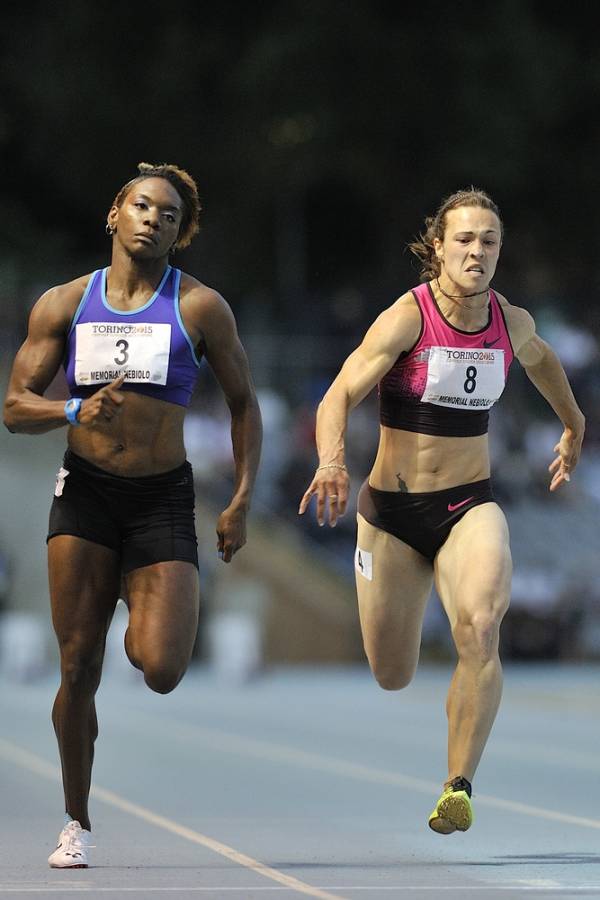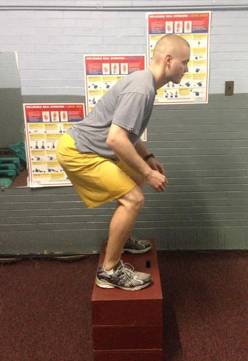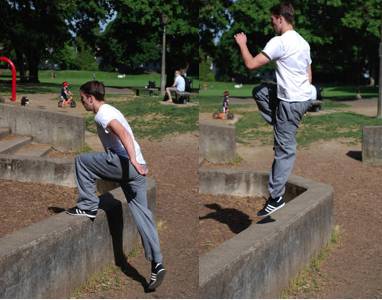The term “plyometrics” was born in the late 1970s in the United States thanks to the work of Fred Wilt (1920-1994), a long-distance runner and member of the U.S. Olympic Team in 1948 and 1952. After his retirement from racing, Wilt became the coach of the women’s running team at Purdue University. His greatest merit was to have popularized in the United States the “jump training” method of the coaches of the Soviet Bloc, thus coining the term “plyometrics.”
The term “plyometrics” was born in the late 1970s in the United States thanks to the work of Fred Wilt (1920-1994), a long-distance runner and member of the U.S. Olympic Team in 1948 and 1952. After his retirement from racing, Wilt became the coach of the women’s running team at Purdue University. His greatest merit was to have popularized in the United States the “jump training” method of the coaches of the Soviet Bloc, thus coining the term “plyometrics.”
An excerpt from Wilt’s Modern Athlete and Coach article of 1978, Plyometrics – What It Is and How It Works read:
The word plyometric is apparently derived from the Greek word plethyein, which means to increase, and isometric. My present interpretation of plyometric is that it means the exercises or training drills used in producing an overload of isometric-type muscle action which invokes the stretch reflect in muscles. I am not particularly happy with this interpretation, and it may alter when a precise definition involves.
There have been many discussions related to the different meanings and use of the words “plyometric” and “pliometric.” Basically, the term “plyometric” is related to the benefits of a “pliometric” training regimen. So, practically, the term “pliometric” refers to the specific type of training regimen while the term “plyometrics” refers to the drills and exercises.2
John A. Faulkner, professor of Molecular and Integrative Physiology and Biomedical Engineering, wrote that the term “pliometric” derived from coupling of Greek prefix “plio” (longer) with the word “metric” which indicated a measurement, so that “plyometric” exercises are designed to obtain the greatest power output during the overcoming phase of the movement thanks to the pre-stimulation of muscle occurring during the eccentric (pliometric) phase.
In addition, Vladimir Zatsiorsky, PhD, professor of kinesiology and director of Penn State’s Biomechanics Laboratory, wrote, “I mentioned this way of training (drop jumps etc.) in my book, Motor Abilities of Athletes, published in 1966 and translated into many languages. I do not remember whether I called this training ‘shock training’ or not and if I suggested this term. In any case, this is not any big deal. The commonly accepted in the American literature term ‘plyometric’ is a misnomer, which was simply a synonym for eccentrics MCS [muscle contraction].”

In 2003, Paavo V. Komi, professor and director of the Neuromuscular Research Center of University of Jyvaskyla, wrote that plyometrics are exercises that involve the stretch-shortening cycle (SSC) and that, “SSC muscle function has a well-recognized purpose: enhancement of performance during the final phase (concentric action) when compared to the isolated concentric action.”
Therefore the term plyometrics refers to the increase of the expression of concentric strength that occurs following a rapid eccentric contraction (due to the stretch reflex). As stated by Natalia Verkhoshansky, “Plyometrics are the exercises in which the pliometric (eccentric) regime is used to increase the power output of movement executed in miometric (concentric) regime.” Dan Pfaff also wrote that, “Current research indicates that this type of muscle loading prepare the muscles to react to stresses similar to those encountered in event specific conditions.”
The benefits of plyometric regime training are primarily related to its ability to improve the responsiveness of the neuromuscular system, thereby allowing greater force production in the concentric phase of the stretch-shortening cycle. This happens thanks to two key mechanisms:
- Myogenic: The utilization of the elastic energy storage in muscle-tendon tissue
- Neurogenic: The alteration of the timing and firing rates of the motor units involved in myotatic reflex (spinal and supra-spinal influences)
According to Dan Pfaff, plyometric training can significantly bridge the gap between strength and power output, thanks to its ability to improve the neuromuscular system reactivity allowing an higher power output in the concentric phase of the movement. The need to implement plyometrics within a training periodization comes from the observation that there are a high number of strong athletes who fail to transfer their strength into efficient movement. From a methodological point of view, plyometrics is a bridge between strength training and speed training.
Plyometrics can be divided into:
- Non-impact plyometrics, are defined as the exercises with a reversible regimen (rapid passage between the eccentric and concentric phase) of muscle work without additional external force impact.
- Impact plyometrics, are defined as exercises with a reversible regimen of muscle work with additional external force impact.
Impact plyometrics can be classified into low-impact plyometrics (with contact times of less than 250ms) and high-impact plyometrics (with contact times greater than 250ms). The former are used to increase the specific power in speed-dominant sport in which the resistance to be overcome is low, while the latter are used for training power in the sport in which the resistance to be overcome is the highest.
Example of exercises:
- Non-impact plyometrics (barbell jump squat)
- Low-impact plyometrics (jump rope, medicine ball throw, skip, box jump)
- High-impact plyometrics (jumps between obstacles, drop jumps, depth jumps)

The intensity of plyometrics can be classified into five levels in which the lower intensities are represented by the numbers five and four, and refer to the low-impact plyometrics (rope, medicine ball throw, skip, jump between obstacles, box jump) and higher intensities are represented by the numbers three through one, and relate to the high-impact plyometrics (drop jumps, depth jumps).
Plyometric training progression, at methodological level, must follow these three phases:
- Exercises with concentric action or reduced eccentric action (medicine ball, rope jump, skip, jump to the top).
- Exercises with concentric-eccentric-concentric action (jumps, jumps between obstacles).
- Exercises with concentric-eccentric action (drop jumps, depth jumps).
Dan Pfaff, in Guidelines for the Implementation of Plyometric Training, identified eight key points in the development and implementation of plyometrics in athletics:
- Respecting the progressive overload principle
- Gradual progression and great attention to recovery (plyometrics is very taxing at CNS level)
- Correct execution technique (foot placement, arm action and recovery mechanisms)
- Focus on the rate of muscle pre-stretch rather than the magnitude of muscle stretch
- Progression of jump training from multi-jumps, to endurance bounding, to depth jumps
- Gradual and progressive increase in volume until you reach the highest volume six to eight weeks before the competitive phase begins
- Using plyometrics according to sport specific demands and according to macrocycle and microcycles objectives. Random use of plyometrics can be counterproductive
- Principle of specificity: the more closely one designs a series to the demands of his or her event, the higher the carryover.

Plyometric training is a very demanding method for central nervous system and neuromuscular system. It is very important to understand how and when to implement a plyometric training regime in a periodization program according to the individual needs, goals and recovery patterns. It is of primary importance to manipulate load training variables efficiently (sets, reps, recovery, frequency) to ensure an optimal training stimulus, efficient recovery and preventing injury.
References:
1. Dan Pfaff, Guidelines for the Implementation of Plyometric Training, Louisiana State University, 1995.
2. Natalia Verkhoshansky, “Shock Methods and Plyometrics: updates and an in-depth examination.” CVASPS, 2012.
3. Yury Verkoshansky, Special Strength Training – A Practical Manual for Coaches, Ultimate Atlete Concept, 2006.
4. Tudor Bompa, Power Training for Sport, 2nd edition, Mosaic Press/Coaching Association of Canada, Oakville, 1996.
5. Fred Wilt, “Plyometrics – What It Is and How It Works,” Modern Athlete and Coach, 1978, 16.
6. Carlo Buzzichelli, “Pianificazione e programmazione della forza,” Tudor Bompa Institute Italia, 2011
Photo 1 courtesy of Modern Athlete and Coach.
Photo 2 courtesy of Shutterstock.
Photo 3 courtesy of Ryan Kish.
Photo 4 courtesy of Ben Muholt.






